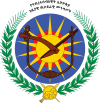This article may require copy editing for grammar and general style. (May 2024) |
| Unitary Marxist-Leninist one-party provisional government under a military junta (1974–1987) Unitary Marxist-Leninist one-party socialist republic (1987–1991) | |
 Emblem of the Provisional Military Administrative Council (Derg) | |
| Formation | 12 September 1974 |
|---|---|
| Extinction | 28 May 1991 |
| Country |
|
| Legislative branch | |
| Legislature |
|
| Chair |
|
| Meeting place | National Palace, Addis Ababa, Ethiopia |
| Executive branch | |
| Mengistu Haile Mariam (1987–1991) | President and General Secretary |
| Fikre Selassie Wogderess (1987–1989) | Prime Minister |
| Haile Yimenu (1989–1991) | Prime Minister |
| Tesfaye Dinka (1991) | Prime Minister |
The government of the Derg consisted of Unitary Marxist-Leninist one-party system with communist and later socialist ideology. Opposing feudal system of Ethiopia, the Derg abolished land tenure in March 1975 and began sweeping land reform under Land Reform Proclamation. All means of goods have been therefore nationalized by the regime including housing, land, farms, and industry.
The term "Ethiopian socialism" embodying slogan "self-reliance", the dignity of labor, and "the supremacy of the common good" allowed peasants to freely distribute their land and form peasant associations. In 1984, the Derg formed Workers Party of Ethiopia (WPE) headed by Mengistu Haile Mariam and formalized the establishment of the People Democratic Republic of Ethiopia in 1986.
The Derg devoted itself aligning Eastern bloc (Soviet Union, Cuba, and Eastern European states) from the beginning with Soviet Union considered "natural ally to Ethiopia". However, the fall of communism in East Europe in 1989 contributed decline of socialism and loss of connection with the Soviet Union—by March 1990–socialism was waned away and the Derg renamed its ruling party as the Ethiopian Democratic Party (EDP), with membership open to non-Marxists.
